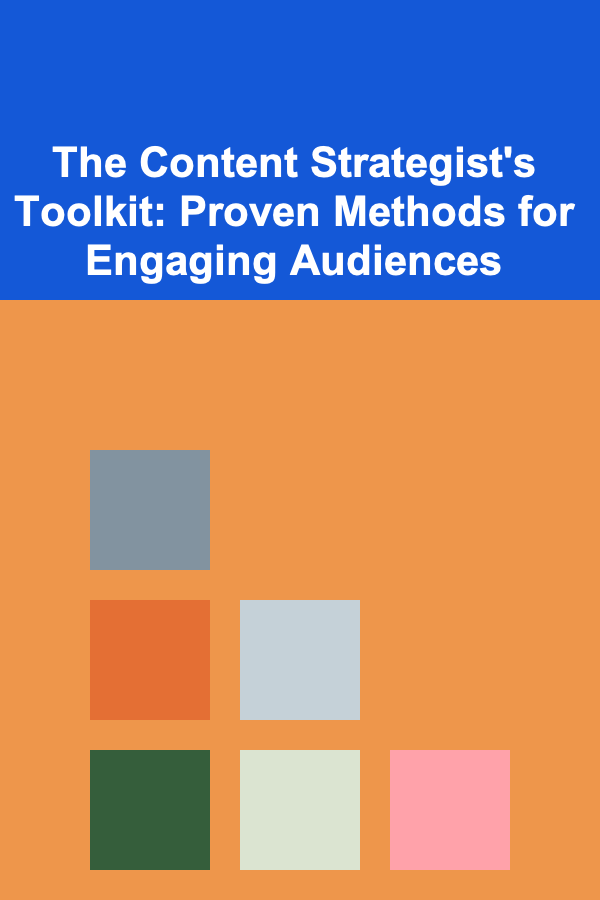
The Content Strategist's Toolkit: Proven Methods for Engaging Audiences
ebook include PDF & Audio bundle (Micro Guide)
$12.99$10.99
Limited Time Offer! Order within the next:

In an age where audiences are bombarded with content from every direction, creating content that stands out is a challenge. A well-crafted content strategy not only ensures that your message reaches the right people but also engages them in a way that drives meaningful actions. Whether you're an experienced content strategist or someone looking to refine your approach, this actionable guide offers proven methods to engage your audience and create content that resonates.
Understanding the Role of a Content Strategist
A content strategist's primary goal is to craft and execute a content plan that aligns with business objectives and speaks directly to the audience's needs and interests. The strategist must understand the brand's voice, audience demographics, and the broader content landscape to effectively engage the target audience.
The role involves:
- Researching the target audience: Understanding the demographics, preferences, pain points, and behaviors of the audience.
- Defining clear objectives: Knowing what the content aims to achieve, whether it's brand awareness, lead generation, or customer retention.
- Creating a content plan: Outlining the topics, formats, and channels to distribute content.
- Measuring success: Using analytics to track the performance of content and adjusting strategies accordingly.
In this toolkit, we will break down actionable methods that successful content strategists employ to capture and retain audience attention.
Know Your Audience Deeply
A strategy without audience insights is like sailing without a compass. To create content that truly engages, you must know exactly who your audience is and what they want.
Audience Research
The first step is to conduct thorough research to understand the demographics, preferences, and pain points of your target audience. This research should focus on:
- Demographics: Age, gender, location, income, occupation.
- Psychographics: Interests, values, opinions, lifestyle.
- Pain Points: Challenges or problems the audience faces that your product or service can solve.
- Behaviors: How your audience consumes content (e.g., social media, blogs, podcasts, videos) and when they engage with it.
Tools for Audience Research
- Surveys & Polls: Tools like SurveyMonkey or Google Forms help gather direct insights from your audience.
- Social Listening: Platforms like Hootsuite and Brandwatch allow you to monitor what people are saying about your industry, brand, or product.
- Google Analytics: Provides demographic and behavioral data on visitors to your website, offering insights into what types of content they engage with.
By analyzing these insights, you can create content that directly speaks to your audience's needs and interests.
Craft Clear and Compelling Content Goals
Without a clear objective, content can quickly lose its effectiveness. A successful content strategy begins with setting clear, measurable goals.
Setting SMART Goals
When setting goals, use the SMART framework:
- Specific: What exactly do you want to achieve? For example, increasing website traffic by 20%.
- Measurable: How will you track your success? This could be through metrics like page views, social shares, or conversion rates.
- Achievable: Are the goals realistic given your resources and timeline?
- Relevant: Do the goals align with your overall business objectives?
- Time-bound: Set a timeframe for achieving these goals.
For example, a goal could be: "Increase blog traffic by 30% within the next six months by publishing two in-depth articles per week targeting long-tail keywords."
Align Content with Business Objectives
Make sure your content aligns with the broader objectives of the business. If the company is focused on increasing product sales, create content that educates and nurtures potential customers through the buyer's journey.
Develop a Content Calendar
Consistency is key in content marketing. A content calendar ensures that you are regularly publishing fresh, relevant content to engage your audience.
How to Build a Content Calendar
- Identify Content Themes: These are overarching topics that align with both your business objectives and audience interests.
- Brainstorm Specific Topics: Within each content theme, brainstorm individual blog posts, social media updates, videos, podcasts, or any other content formats.
- Choose Content Formats : Not all content is the same. Mix up your content formats to cater to different preferences. For example:
- Blogs for in-depth information
- Infographics for quick, digestible insights
- Video content for engagement
- Podcasts for auditory learners
- Set a Publishing Schedule: Decide how frequently you'll publish each piece of content. You may choose to post blog articles weekly and social media posts daily, depending on your resources.
- Coordinate with Other Teams: Ensure the content calendar aligns with other departments like product launches, marketing campaigns, and public relations efforts.
Tools to Manage Your Content Calendar
- Trello: A popular tool for visualizing content workflows and timelines.
- Asana: Great for project management and content creation timelines.
- CoSchedule: Specifically designed for content planning, scheduling, and social media integration.
Leverage SEO for Content Discovery
SEO is a fundamental part of content strategy. Without proper search engine optimization, your content may not reach its intended audience. Integrating SEO into your content ensures your content is discoverable and drives organic traffic.
Keyword Research
Begin by identifying relevant keywords your audience is searching for. Use tools like:
- Google Keyword Planner: A free tool for identifying search volume and competition for keywords.
- Ahrefs: Provides in-depth keyword analysis, backlinks, and SEO opportunities.
- SEMrush: Helps identify top-performing keywords in your niche and track competition.
On-Page SEO Best Practices
Once you have your keywords, integrate them naturally into your content. Important places to include keywords are:
- Title tags and meta descriptions
- Headings (H1, H2, H3)
- Body content
- Image alt texts
- URL slugs
User Experience and Mobile Optimization
Google's ranking algorithm increasingly focuses on user experience (UX) and mobile-friendliness. Ensure that your content is easy to read, with clear formatting, fast load times, and is fully optimized for mobile devices.
Create Content that Solves Problems
Content should always be focused on delivering value to your audience. Content that solves problems builds trust and encourages engagement.
Problem-Solving Content Types
- How-to Guides: These provide actionable steps to solve specific problems.
- Case Studies: Demonstrate real-world examples of how your product or service has solved a problem for a customer.
- FAQs: Anticipate and answer questions your audience might have.
- Interactive Tools or Quizzes: These let users engage and receive personalized insights, which can be highly effective for lead generation.
Providing Solutions at Every Stage of the Funnel
Tailor your content to meet your audience's needs at every stage of the buyer's journey:
- Top of Funnel: Create awareness with educational content like blog posts, infographics, and videos.
- Middle of Funnel: Provide value through case studies, webinars, and eBooks that demonstrate how your offering can solve specific problems.
- Bottom of Funnel: Use testimonials, product demos, and trials to convert leads into customers.
Use Data and Analytics to Continuously Improve
To stay ahead in content strategy, continuous improvement is crucial. Regularly reviewing analytics allows you to refine your approach and increase engagement over time.
Key Metrics to Track
- Traffic: How many people are visiting your content? Where are they coming from (organic search, social media, referrals)?
- Engagement: Are your readers commenting, sharing, or liking your content? Higher engagement indicates that your content resonates.
- Conversions: Are your visitors taking the desired action (e.g., signing up for a newsletter, making a purchase)?
- Bounce Rate: A high bounce rate could indicate that your content isn't engaging enough or doesn't match what your audience expected.
Tools for Tracking Performance
- Google Analytics: Provides detailed insights into user behavior on your website.
- Social Media Insights: Platforms like Facebook, Twitter, and LinkedIn provide engagement metrics for your posts.
- HubSpot: A comprehensive inbound marketing tool that integrates analytics across content, social media, and leads.
Focus on Quality Over Quantity
While consistency is important, quality should always trump quantity. Engaging your audience with high-value content will build a loyal following. Prioritize content that is informative, well-researched, and original.
Tips for High-Quality Content
- Research Thoroughly: Content should be well-researched and fact-checked to provide real value to your audience.
- Craft Compelling Headlines: A catchy, curiosity-driven headline is essential to drive clicks.
- Use Visuals: Visuals such as images, infographics, and videos not only make your content more appealing but also improve engagement.
- Tell Stories: People connect with stories. Use storytelling to make your content more relatable and memorable.
Conclusion
The role of a content strategist is dynamic and requires a deep understanding of both the audience and the tools that facilitate content creation, distribution, and optimization. By knowing your audience, setting clear goals, developing a content calendar, leveraging SEO, solving problems, and continuously refining your approach, you can create content that resonates and drives engagement.
Remember that the key to success in content strategy is a balance between creativity and data-driven decisions. By mastering these techniques, you will position yourself as a content strategist capable of driving meaningful audience engagement and delivering real results.
Reading More From Our Other Websites
- [Tiny Home Living Tip 101] How to Create a Cozy Tiny Home Fireplace That Meets Safety Codes
- [Organization Tip 101] How to Organize Your Cleaning Supplies for Quick Access
- [Home Pet Care 101] How to Introduce New Pets to Your Household Successfully
- [Home Space Saving 101] How to Store Cleaning Supplies Efficiently in a Small Space
- [Home Budget 101] How to Start a Home Budget with a Small Income
- [Organization Tip 101] How to Set Intentions for Each Week Mindfully
- [Scrapbooking Tip 101] How to Choose the Perfect Scrapbooking Paper Pad: A Beginner's Guide
- [Survival Kit 101] Step-by-Step DIY Survival Kit Checklist: How to Customize Your Emergency Supplies
- [Weaving Tip 101] A Guide to Choosing the Perfect Weaving Tools for Your Craft
- [Simple Life Tip 101] Best Budget‑Friendly Meal Planning Strategies for a Streamlined Kitchen

How to Budget for Weddings and Family Celebrations
Read More
How to Conduct a Regular Office Clean-Up Day
Read More
How to Create a Vintage-Inspired Reading Nook
Read More
How to Enjoy Your Free Time with the Best Low-Cost Entertainment Options
Read More
How to Set Up a Paperless Office Environment
Read More
10 Tips for Budgeting Personal Care on a Tight Income
Read MoreOther Products

How to Budget for Weddings and Family Celebrations
Read More
How to Conduct a Regular Office Clean-Up Day
Read More
How to Create a Vintage-Inspired Reading Nook
Read More
How to Enjoy Your Free Time with the Best Low-Cost Entertainment Options
Read More
How to Set Up a Paperless Office Environment
Read More